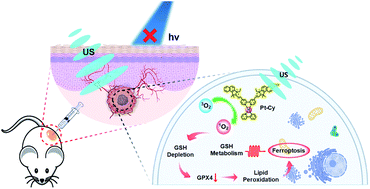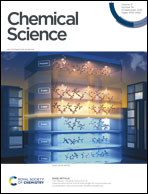Ferroptosis promotes sonodynamic therapy: a platinum(ii)–indocyanine sonosensitizer†
Abstract
Sonodynamic therapy (SDT) has unique advantages in deep tumour ablation due to its deep penetration depth, showing great preclinical and clinical potential. Herein, a platinum(II)–cyanine complex has been designed to investigate its potential as a SDT anticancer agent. It generates singlet oxygen (1O2) under ultrasound (US) irradiation or light irradiation, and exhibits US-cytotoxicity in breast cancer 4T1 cells but with negligible dark-cytotoxicity. Mechanistic investigations reveal that Pt-Cy reduces the cellular GSH and GPX4, and triggers cancer cell ferroptosis under US irradiation. The metabolomics analysis illustrates that Pt-Cy upon US treatment significantly dysregulates glutathione metabolism, and finally induces ferroptosis. In vivo studies further demonstrate that Pt-Cy inhibits tumor growth under US irradiation and its efficiency for SDT is better than that for PDT in vivo. This is the first example of platinum(II) complexes for sonodynamic therapy. This work extends the biological applications of metal complexes from PDT to SDT.

- This article is part of the themed collection: Most popular 2022 organic chemistry articles


 Please wait while we load your content...
Please wait while we load your content...